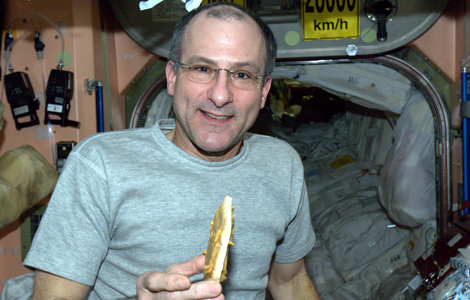
Whenyour slice of bread falls on the floor, everyone anxiously looks to see if itlanded jelly side up or jelly side down. Simple probability gives a 50-50chance either way, but it seems more correlated to the difficulty of cleaningthat particular section of flooring.
Onspace station the probabilities are still the same, but the results aredifferent. I fumbled my bread after spreading a generous layer of my favoriteconcoction, peanut butter and honey. It sped toward the overhead panel and hitit before I could intervene. Fortunately, it landed jelly side out (it’s interesting how many figuresof speech have gravity-oriented references), so the 50-50 odds were in my favorthis time.
Unfortunately, it ricocheted and sped off in a different direction.I noticed that the angle of incidence equaled the angle of reflection. Myearth-honed intuition anticipated a different motion, so I was not able to keepup with the errant slice. Like a real-life version of the game “asteroids,” itwent on to hit a second panel. Jelly side was out again, so the 50-50 statistics were still in my favor. One moretime my hand was lagging the trajectory. Like failing to flip heads three timesin a row, the third collision was jelly side in, which immediately halted all motion. And just like on Earth,the outcome seemed related to the difficulty of cleaning the landing zone.After having hit two easy-to-clean aluminum panels, it landed on a white fabriccovering on a patch of Velcro pile.
Thefatalist in me accepts the inevitable Zero-G result of landing jelly side“down,” so I decided to make sure the probability would always be 100%.Realizing that the bread is merely a vehicle for conveying peanut butter andhoney, I decided to spread it on both sides. In weightlessness, it’s easy tobalance your slice on its edge so that it can be parked on the galley tablewithout any fuss. And the result is pure tastebud heaven. I do it this waybecause I am in space, and I can.
Don’s blog also appears at airspacemag.com.

